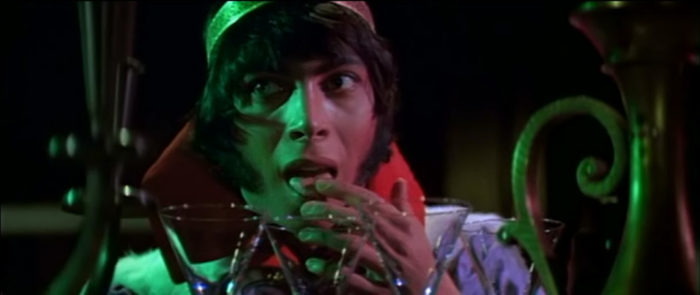
Russ Meyer’s Beyond The Valley Of The Dolls is the kind of film that makes you question what the point is of giving out star ratings. Because here, concepts like “good” or “bad” are kind of beside the point. This movie attacks all common decency and is all the better for it. Again, I have a very hard time rating it in comparison to any of the other films we’ve reviewed this month, but Beyond The Valley Of The Dolls is so overstuffed with characters and music and colors and of course tits, that it’s kind of hard not to enjoy on some level. Basically, there’s just a lot of movie packed into this movie.
First of all, I have not seen Valley Of The Dolls, the 1967 film that Beyond was originally intended to be a sequel to, but instead ended up as a quasi-remake/spoof of the original. Much like the original, it centers on a trio of women in a rock band who move out to Los Angeles to hit it big. The girls, playing under the name The Carrie Nations, come under the tutelage of an eccentric manager named Z-Man (played by John LaZar), while their lead singer Kelly (Dolly Read) becomes enamored with a male gigolo, fittingly named Lance Rocke. Oh, and everybody fucks a lot and does lots of drugs.
I could continue recounting the plot of this movie, but I would just be recapping what’s on wikipedia, because I honestly don’t think the movie is terribly interested in the specifics of its plot. Which is perhaps a little disappointing, since a sizable chunk of my curiosity with Beyond The Valley Of The Dolls was that it was written by Roger Ebert (no, seriously). But from Ebert’s later reflections on the making of the film, it sounded like he didn’t really know what he was doing, since he hadn’t written a film before, and was there mainly as a co-conspirator in bringing Russ Meyer’s sexed-up vision of ’60s counterculture to the screen.
And even though the film was released in 1970, it definitely feels incredibly indicative of the sixties cultural revolution, if in a very kitschy way. It’s no coincidence that Austin Powers himself quotes the film’s memorable line “This is my happening and it freaks me out!” Of course, whether that line is meant to be a tongue-and-cheek jab at ’60s hippie-isms is debatable, but that’s another key part of the film’s tone. Ebert described Beyond The Valley Of The Dolls as a satire of Hollywood conventions, and I’ll take his word for it since much of the dialogue is beyond campy, while the actors still deliver it with the sincerity of Shakespeare. However, it seems like a lot of the genres being satirized are very era specific, so they don’t entirely track as parody, even for a 60s fluent viewer like myself.
But that doesn’t really matter, since the style this film is shot in is so unrelentingly kinetic and, er… stimulating. The early scenes of BTVD took me a bit of getting used to, as there’s a party scene in which the dialog is cut in a very jarring way, while dayglo images of debauchery flood the viewer. But somehow it all hangs together, if just by a thread. Honestly, I’m not sure why this movie worked for me. Maybe just because it is working on such a high level of camp, and as far as making trash goes, Russ Meyer clearly had a masterful way of shooting his well-endowed leading ladies.
I know, it probably sounds a bit like I’m just trying to elevate a movie that is merely just obsessed with big tits. And there’s no mistaking, this movie is pretty obsessed with big tits. But Meyer is also working on a different level than mere pornographers, as the movie’s gratuitous amount of sex and nudity is just one piece of the film’s bombastic puzzle, which also features lots of musical numbers, lots of big performances (John LaZar as Z-Man is particularly memorable), while there’s even a surprising amount of graphic violence in its finale. And if you don’t believe me that there’s a considerable amount of craft here, I recommend this interview with John Waters, whose disregard for taste was hugely indebted to Russ Meyer.
But perhaps the most striking thing about watching this film is seeing just how much the movie industry and American culture at large had changed by the tail end of the ’60s. Especially because in the review of my last Criterion film, The Naked Kiss, I talked about how a movie like that in 1964 could’ve only gotten produced at a smaller B-movie studio, even when all of that film’s lurid subject matter is only alluded to or happens offscreen. Yet here’s a movie filled with tons of onscreen sex, drugs, and violence, which was released just six years later, and by 20th Century fucking Fox. That said, the film was slapped with a deserved X rating, but it’s still insane to me that a major movie studio would ever release something like this. But hey, it’s never a bad idea to let the lunatics run the asylum, if just for one brief fleeting moment.


